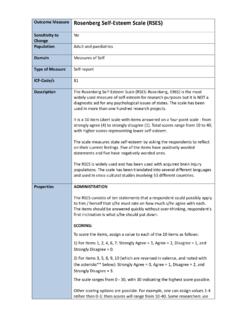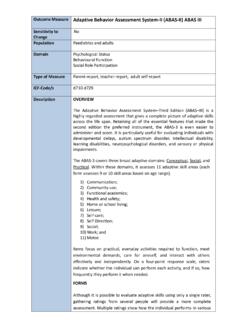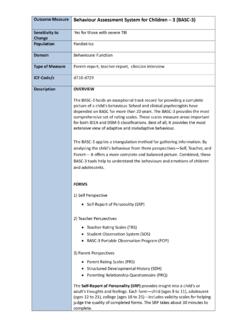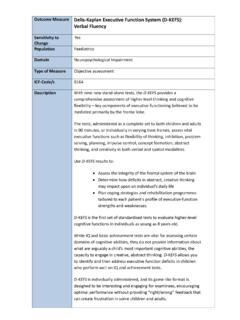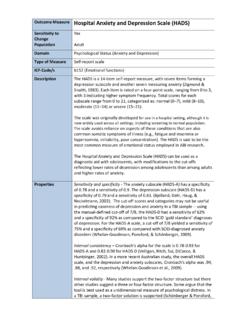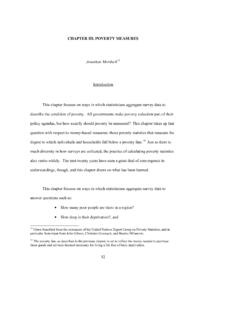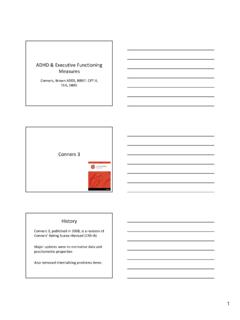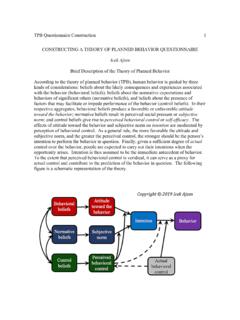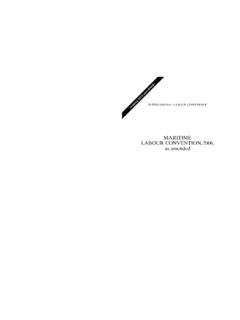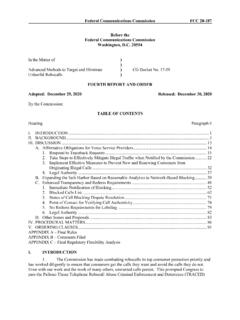Transcription of Outcome Measure Social Skills Improvement System (SSIS ...
1 Outcome Measure Social Skills Improvement System (SSIS) Rating Scales Sensitivity to Change Yes Population Paediatrics Domain Social Role Participation and Social Competence Behavioural Function (*to be removed from this domain*) Type of Measure Parent-report, teacher-report, self-report ICF-Code/s d710-d729 Description OVERVIEW The Social Skills Improvement System (SSIS: Gresham & Elliot, 2008) Rating Scales enables targeted assessment of individuals and small groups to help evaluate Social Skills , problem behaviors, and academic competence. It was designed to replace the SSRS Social Skills Rating System . The SSIS can be used to assess children with behavioural and interpersonal Skills difficulties, screen for problem behaviours, and identify students at risk for Social behavior difficulties and poor academic performance. In addition, it can be used to identify specific Social behaviour acquisition and performance deficits that can be addressed with skill-building school and home interventions and identify Social Skills strengths.
2 It is also used to provide a baseline for post-intervention progress evaluation as well as to track progress. It is a multi-rater series of rating scales that includes ratings from teachers, parents, and students. The SSIS RS assesses three domains in children aged 3-18 years: 1) Social Skills : Communication (7), Cooperation (6), Assertion (7), Responsibility (6), Empathy (6), Engagement (7), Self-Control (7) 2) Competing Problem Behaviors: Externalizing (12), Bullying (5), Hyperactivity/Inattention (7), Internalizing (7), Autism Spectrum (7) 3) Academic Competence (teacher form): reading, math, motivation, parental support, and general cognitive functioning. STRUCTURE There are forms for the student (ages 8-18 only), parents, and teacher. Each form takes 10 to 25 minutes to complete. The number of items differs based on the form and age of child.
3 There are approximately 140 items per form. On the student form, students rate how true various sentences are about them on a 4-point scale: not true, a little true, a lot true, very true. On the parent and teacher forms, parents and teachers rate the frequency that various behaviours are exhibited by the student on a 4-point scale. Teachers and parents indicate the frequency with which the student exhibits each Social skill and problem behavior on a 4-point scale of n e v e r, seldom, often, and almost always. Students indicate how true a statement about each Social skill and problem behavior is for them using a 4-point scale of not true, a little true, a lot true, and very true. In addition, teachers, parents, and students indicate the importance of each Social skill to the student's development and classroom success using a 3-point scale of not important, important, and critical.
4 The forms can be hand scored or computer scored. Reports are generated from the scoring software. There are detailed instructions on scoring and interpreting the scores in the manual. The manual also provides instructions when collecting data from multiple raters. The normative sample included 4,700 students aged 3 through 18; 385 teachers; and 2,800 parents. Item development of the SSIS was based on a broad review of the empirical literature on Social Skills deficits in special populations, reviews of published empirical studies using an earlier version of the scale (Gresham & Elliott, 1990), and research on the relationship between specific Social behaviors and important Social outcomes. Properties Age: 3:0 to 18:0 years old Reading Level: Parent - 5th grade; Student - 2nd grade Completion Time: 10-25 minutes Scores / Interpretation: Social Skills , Problem Behaviors, and Academic Competence scales Standard scores and percentile ranks; Subscales Behavior Levels (below average, average, above average); Items Frequency and Importance ratings point to behaviors that may require intervention.
5 The SSIS Rating Scales may be hand-scored. For added convenience, use the ASSIST software which provides computer scoring and reporting, including individual, progress and multi-rater reports and a direct link to suggested interventions with the SSIS Intervention Guide. Psychometric Properties: 1) Reliability : see Gresham & Elliott, 2008 2) Internal Reliability: Good 3) Te s t-Retest Reliability: Good 4) Validity: see Gresham & Elliott, 2008 5) Criterion Validity: The manual demonstrates evidence of adequate criterion validity. 6) Convergent Validity: The SSIS manual reports adequate support for the convergent and discriminant validity of the SSIS rating subscales. 7) Correlations between SSIS and other rating scales demonstrated low or moderate correlations. See Elliot et al. (1988). Measure selected for CDE by the inter-agency Pediatrics TBI Outcomes Workgroup.
6 The SSIS manual provides extensive validity evidence based on test content, internal structure, intercorrelations among scales and subscales, item-total correlations, and relations with other variables. Intercorrelations among scales and subscales for each form are moderate to high for the Social Skills and Problem Behavior subscales. Item-total correlations across forms by age tend to be moderate to high, many of which exceed .70 .80. Correlations between the SSIS and the BASC 2 (Reynolds & Kamphaus, 2004) are moderate to high. For example, the median correlations between the SSIS total Social Skills score and the teacher form of the BASC 2 Social Skills score are .78 and .69 for the teacher and parent forms, respectively. Correlations between the SSIS total Social Skills scores and the socialization scores of the Vineland Adaptive Behavior Scales, Second Edition (Sparrow, Cicchetti, & Balla, 2005) are.
7 65 and .44 for the teacher and parent forms, respectively. The SSIS is published by Pearson Clinical Assessments. 19500 Bulverde Road, San Antonio, TX 78359. Advantages 1) The SSIS is a revised version of the widely used SSRS, which has a strong history of use in schools. 2) In review by Crowe et al (2011) rated best Measure of Social Skills available, and most widely used. 3) Wide age range 3-18 years, good psychometric properties. Disadvantages 1) No data as yet regarding what profiles are expected after child TBI. 2) There is extensive research and information on the Social Skills Rating System , but not as much has been done on the newer SSIS. Also, the cost of the SSIS is high compared to other surveys. Knowledge of compiling data and creating reports may also be necessary, as this is not included in the software package. Additional Information The Social Skills Improvement System addresses the need for an evidence-based, multi-tiered assessment and intervention System to help students develop, improve and maintain important Social Skills .
8 Designed by experienced scientist-practitioners Stephen Elliott, PhD and Frank Gresham, PhD, this family of tools can be used early in the school year to facilitate the universal screening of students at risk for academic or Social behavior difficulties, help plan interventions for improving these behaviours, and evaluate progress on targeted Skills after intervention. The SSIS focuses on key Skills that enable the academic success of students 3 19. The SSIS family of assessment and intervention tools are: Performance Screening Guide Offers universal screening of prosocial behaviours, math Skills , reading Skills , and motivation to learn for all students in an entire classroom in less than 20 minutes. The Social Skills Improvement System (SSiS) Performance Screening Guide fills the need for a time-efficient tool for class-wide screening of key Social , motivational, and academic Skills .
9 For use by teachers with students in preschool through secondary school, this universal screening instrument helps assess and document the performance level of all students, not just those in greatest need of intervention. Classwide Intervention Program Provides teachers and other professionals Social Skills instructional scripts and resources for teaching the top 10 Skills that are critical to functioning of all students with a classroom. The Social Skills Improvement System (SSiS) Class-wide Intervention Program provides teachers with a structured, yet flexible and efficient way to teach 10 of the most important Social Skills to students from preschool to early adolescence. The SSiS Class-wide Intervention Program has been designed in conjunction with the SSiS Performance Screening Guide to provide a coordinated System for improving Social Skills .
10 The program includes lesson plans, workbook, videos, certificates and more. Reviewers Vicki Anderson Cathy Catroppa References Elliott, SN, Gresham, FM (2007) Social Skills Improvement System : Performance screening guides. Pearson Assessments, Bloomington, MN Elliott, SN, Gresham, FM (2008) The SSIS ASSIST: Scoring, interpretation, and report writing program. Pearson Assessments, Bloomington, MN Gresham, FM, Elliott, SN (2008) Social Skills Improvement System : Rating scales. Pearson Assessments, Bloomington, MN Gresham, FM, Elliott, SN (1990) Social Skills Rating System . NCS Pearson, Minneapolis, MN Reynolds, C, Kamphaus, RW (2004) Behaviour Assessment System for Children. NCS Pearson, Minneapolis, MN Sparrow, SS, Cichetti, DV, Balla, DA (2005) Vindeland Adapative Behaviour scales: Parent/caregiver rating form. NCS Pearson, Minneapolis, MN

